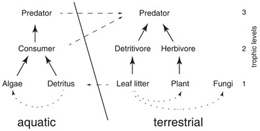Research Abstract
日本の森林生態系におけるセシウム137の腐食連鎖系を通じた生物学的拡散
Biological proliferation of cesium-137 through the detrital food chain in a forest ecosystem in Japan
2014年1月8日 Scientific Reports 4 : 3599 doi: 10.1038/srep03599

東日本大震災に伴う福島第一原子力発電所の事故で、セシウム137(137Cs)などの放射性核種が放出され、本州東北部の森林域に広く降り積もった。この森林域では、事故前の2010年の秋に落ちて積もった落ち葉の上に、137Csが高濃度で蓄積した。機能群の間での137Cs分布を調査したところ、腐食連鎖が、消費者生物への137Csの移動の主要経路として働いていることが明らかになった。多くの研究によって、栄養的相互作用を通じて放射性物質の生物濃縮(あるいは希釈)が起こることが報告されているが、今回の結果は、複数の経路(植食と腐食連鎖など)で食物網を通じた137Csの生物拡散を調べることの重要性を強く示している。これらの結果は、森林生態系内の137Csの今後の分布および移動について知るための重要な手がかりとなる。
村上 正志1, 大手 信人2, 鈴木 隆央1, 石井 伸昌3, 五十嵐 祥晃1 & 田野井 慶太郎2
- 千葉大学大学院 理学研究科 群集生態学研究室
- 東京大学大学院 農学生命科学研究科
- 放射線医学総合研究所 放射線防護研究センター
Radionuclides, including 137Cs, were released from the disabled Fukushima Daiichi Nuclear Power Plant and had been deposited broadly over forested areas of north-eastern Honshu Island, Japan. In the forest, 137Cs was highly concentrated on leaf litters deposited in autumn 2010, before the accident. Monitoring of the distribution of 137Cs among functional groups clearly showed the role of the detrital food chain as the primary channel of 137Cs transfer to consumer organisms. Although many studies have reported the bioaccumulation (or dilution) of radioactive materials through trophic interactions, the present results highlight the importance of examining multiple possible pathways (e.g., grazing vs. detrital chains) in the proliferation of 137Cs through food webs. These results provide important insight into the future distribution and transfer of 137Cs within forest ecosystems.

